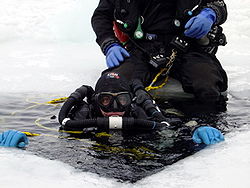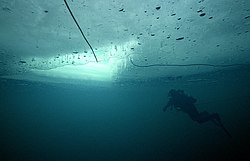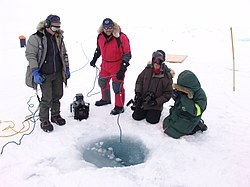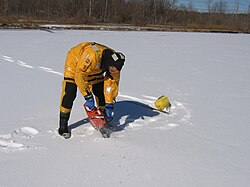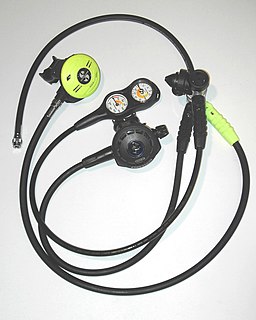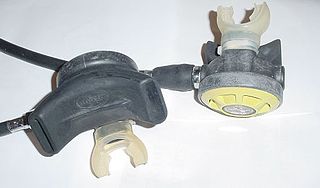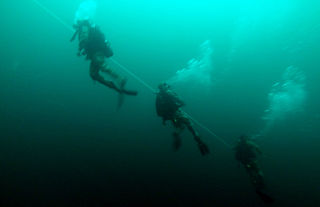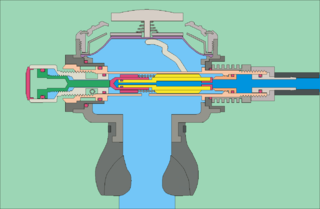Regulator freezing
Regulator freezing is a malfunction of a diving regulator where ice formation on or in one or both stages causes the regulator to function incorrectly. Several types of malfunction are possible, including jamming of the first or second stage valves in any position from closed to more frequently fully open, which can produce a free-flow capable of emptying the diving cylinder in minutes, ice formation in the exhaust valve opening causing leakage of water into the mouthpiece, and shedding of ice shards into the inhalation air, which may be inhaled by the diver, possibly causing laryngospasm. [11]
When air expands during pressure reduction in a regulator, the temperature drops and heat is absorbed from the surroundings. [12] It is well known that in waters colder than 10 °C (50 °F) use of a regulator to inflate a lift bag, or to purge a regulator underwater for just a few seconds, will start many regulators free-flowing and they will not stop until the air supply to the regulator is stopped. Some cold water scuba divers install shuttle type shut off valves at each second stage regulator so if the second stage freezes open, the low pressure air can be shut off to the frozen second stage allowing them to switch to the alternative second stage and abort the dive. [11]
The most familiar effect of regulator freezing is where the second stage demand valve starts free flowing due to ice formation around the inlet valve mechanism that prevents the valve from closing after inhalation. Besides the problem of free flow from second stage icing, a less known problem is free ice formation, where ice forms and builds up inside the second stage but does not cause the regulator to free flow, and the diver may not be aware that the ice is there. This free ice build-up inside the second stage can break loose in the form of a sliver or chunk and pose a significant choking hazard because the ice can be inhaled, which may trigger laryngospasm. This can be a particular problem with regulators having ice-shedding internal surfaces that are teflon coated, which allows the ice to break free of the internal surfaces and helps to prevent the regulator from free flowing by clearing the ice. This may be helpful in keeping the demand valve mechanism free to move, but the ice still forms in the regulator and has to go somewhere when it breaks loose. [11]
With most second stage scuba regulators, ice forms and builds up on internal components, and the gap between the valve lever and fulcrum point is reduced and eventually filled by the build-up of ice that forms, preventing the inlet from fully closing during exhalation Once the valve starts leaking, the second stage components get even colder due to the cooling effect of the continuous flow, creating more ice and an even greater free flow. With some regulators the refrigerating effect is so great, that water around the exhaust valve freezes, reducing exhaust flow, and increasing exhalation effort and producing positive pressure in the valve body, making it difficult to exhale through the regulator. This may cause the diver to loosen their grip on the mouthpiece and exhale around the mouthpiece. [11]
With some regulators, once the regulator starts free-flowing the flow escalates into a full free-flow, and delivers air to the diver at temperatures cold enough to freeze mouth tissue in a short time, causing frostbite. The effect increases with depth, and the deeper the diver is, the faster the breathing gas will be lost. In some cold water fatalities, by the time the diver’s body is recovered there is no gas left in the cylinder, and the regulator has warmed up and melted the ice, destroying the evidence, and leading to a finding of death by drowning due to running out of gas. [11]
Mechanism of icing
When the high pressure gas passes through the regulator first stage, the pressure drop from cylinder pressure to inter-stage pressure causes a temperature drop as the gas expands. The higher the cylinder pressure the greater the drop in pressure and the colder the gas gets in the low pressure hose to the second stage. An increase in flow will increase the amount of heat lost and the gas will get colder, as heat transfer from the surrounding water is limited. If the breathing rate is low to moderate (15 to 30 lpm) the risk of ice formation is less. [11]
The factors that influence ice formation are: [11]
- Cylinder pressure: - The temperature drop is proportional to the pressure drop. See general gas equation.
- Breathing or flow rate: - The heat loss is proportional to the mass flow of gas.
- Depth: - Mass flow is proportional to downstream pressure for a given volumetric flow.
- Water temperature: - Rewarming of the expanded gas and the regulator mechanism depends on water temperature, and the temperature difference between the gas and the water.
- Duration of flow:- During high flow rates heat loss is faster than rewarming, and gas temperature will drop.
- Regulator design and materials: - The materials, arrangement of parts, and gas flow in the regulator affect reheating and deposition of ice. The thermal conductivity of the regulator components will affect the rate of heat transfer.
- Breathing gas composition: - The amount of heat needed to raise the temperature depends on the specific heat capacity of the gas.
Once the water temperature drops below 3.3 °C (37.9 °F) there is not enough heat in the water to rewarm the components of the second stage being chilled by the cold gas from the first stage, and most second stages start forming ice. [11]
The cold inter-stage air enters the second stage and is reduced to ambient pressure, which cools it further, so it chills the second stage inlet valve components to well below freezing and as the diver exhales, the moisture in the exhaled breath condenses on the cold components and freezes. Heat from the surrounding water may keep the second stage regulator components warm enough to prevent the build-up of ice. The diver’s exhaled breath at 29 to 32 °C (84 to 90 °F), does not have enough heat to compensate for the cooling effect of the expanding incoming air once the water temperature is much below 4 °C (39 °F), and once the water temperature drops below 4 °C (39 °F) there is not enough heat in the water to rewarm the regulator components fast enough to keep moisture in the divers exhaled breath from freezing if the diver is breathing hard. This is why the CE cold water limit is at 4 °C (39 °F) which is the point at which many scuba regulators start retaining free ice. [11]
The longer the gas expands at a high rate, the more cold gas is produced, and for a given rate of reheating, the colder the regulator components will get. Keeping high flow rates to as short a time as possible will minimise ice formation. [11]
The air temperature above the ice may be considerably colder than the water under the ice, and the specific heat of air is much less than that of water. As a consequence, there is less warming of the regulator body and inter-stage gas when out of the water, and it is possible for further cooling to occur. This increases the risk of second stage icing, and the gas in the cylinder may be cooled sufficiently for condensation of residual moisture to occur during first stage expansion, as the expanding gas may cool below the −50 °C (−58 °F) dew point specified for high pressure breathing gas, which could cause internal icing of the first stage. This can be avoided by restricting breathing from the set in the cold air to a minimum. [3]
A similar effect occurs with the second stage. Air which has already expanded and cooled through the first stage expands again and cools further at the demand valve of the second stage. This cools the components of the second stage and water in contact with them may freeze. Metal components around the moving parts of the valve mechanism allow heat transfer from the surrounding slightly warmer water, and from exhaled air from the diver, which is considerably warmer than the surroundings. [7]
Second stage freezing can develop quickly from the moisture in the exhaled breath, so regulators that prevent or reduce contact of the diver’s exhaled breath with the colder components and the area where the cold gas enters will usually build up less ice on critical components. The heat transfer qualities of the materials can also significantly influence ice formation and freezing risk. Regulators with exhaust valves that do not seal well will form ice quickly as ambient water leaks into the casing. All second stages can develop ice when the inlet gas temperature averages below −4 °C (25 °F) and this can happen in water temperatures up to 10 °C (50 °F). The ice that forms may or may not cause a free flow, but any ice inside the regulator casing may present an inhalation hazard. [11]
A second stage freeze is also likely to happen with the valve open, causing a free flow, which may precipitate a first stage freeze if not immediately stopped. If the flow through the frozen second stage can be stopped before the first stage freezes, the process can be halted. This may be possible if the second stage is fitted with a shutoff valve, but if this is done, the first stage must be fitted with an over-pressure valve, as closing the supply to the second stage disables its secondary function as an over-pressure valve. [7]
Cold water function testing is used to compare a regulator's performance in cold water against various standards, mainly the U.S. Navy Experimental Diving Unit's unmanned cold water test procedures (1994), and European CE open circuit standard EN 250 of 1993. Testing may include failure modes and effects analysis, and other issues relating to manufacturing, quality assurance and documentation. [11] The introduction of a complete computerised breathing simulator system by ANSTI Test Systems Ltd in the UK made possible the accurate breathing simulator testing at all realistic water temperatures that is the current practice. [11]
Surface supplied breathing equipment
In most cases surface supplied helmets and full face mask demand valves do not get cold enough to develop ice because the umbilical works as a heat exchanger and warms the air up to the water temperature. [11] If the surface supplied diver bails out to scuba emergency gas supply, then the problems are identical to those for scuba, though the metal gas block and bent tube gas passages before the second stage will provide some warming of inter-stage gas beyond what a scuba set would normally provide.
If the surface air temperatures are well below freezing, (below −4 °C (25 °F)) excessive moisture from the volume tank can freeze into ice granules which can then travel down the umbilical and end up in the helmet intake, blocking off air to the demand valve, either as a reduction in flow or a complete blockage if the granules accumulate and form a plug. Ice formation in a surface supplied system can be prevented by use of an effective moisture separation system and regular draining of condensate. Desiccating filters can also be used. Use of HP gas for surface supply is not generally a problem as the HP compressors use a filter system that dries the air sufficiently to keep the dew point below −40 °C (−40 °F). Keeping the surface section of the umbilical exposed to the cold air as short as possible will also help. The portion in the water is not normally cold enough to be a problem. [11]
Factors increasing the risk of regulator freeze
- Unsuitable regulator design and construction
- High flow rates through the regulator
- Purging
- Buddy breathing
- Octo breathing
- Filling a lift bag or DSMB from the breathing regulator [1]
- long bursts of dry suit inflation or BC inflation while breathing from the same regulator.
- High breathing rate due to exertion
- Low water temperature
- Water directly under the ice is likely to be colder than deeper water in fresh water.
- Breathing through the regulator above the ice in sub-freezing temperatures
Precautions to reduce risk of regulator freezing
- Keeping the interior of the second-stage completely dry before entering the water [13]
- Not breathing from the regulator until underwater. When testing the regulator before the dive, inhale only, avoid exhaling through the regulator as the moisture in the breath will freeze in the demand valve. [13]
- Preventing water from entering the second-stage chamber during or between dives [13]
- Depressing the purge button for no more than 5 seconds prior to or during the dive, and avoiding even this if possible [13]
- Avoiding heavy work loads that would significantly increase the breathing rate and volume of air moved through the valve with each breathing cycle [13]
- Ensuring that the scuba air is moisture-free [13]
- Keeping the regulator in warm surroundings prior to the dive, if possible. [13]
Mitigation
Kirby Morgan have developed a stainless steel tube heat exchanger ("Thermo Exchanger") to warm the gas from the first stage regulator to reduce the risk of second stage scuba regulator freeze when diving in extremely cold water at temperatures down to −2.2 °C (28.0 °F). [11] The length and relatively good thermal conductivity of the tubing, and the thermal mass of the block allows sufficient heat from the water to warm the air to within one to two degrees of the surrounding water. [11]
Procedures for managing a regulator freeze
- The diver will close the cylinder valve supplying the frozen regulator and change over to breathing from the standby regulator. This conserves the gas and allows the frozen regulator time to defrost.
- If tethered, the diver can signal to the line tender with the previously agreed emergency signal (usually five or more tugs on the rope) while breathing from free-flowing regulator (less desirable option used if no alternative gas supply is available). Five pulls will usually indicate that the surface tender should pull the diver to the surface, or in this case, the hole in the ice.
- If diving without a tether the diver should follow the guideline back to the hole and avoid leaving the line unless able to use a jump line or can see the ice hole.
- Emergency ascent if directly under the hole in the ice and in visible range. (least desirable option short of drowning)
Protocol for a regulator freeze often includes aborting the dive. [13]
Low pressure inflator freeze
It is possible for the dry suit or buoyancy compensator inflation valve to freeze while inflating, for similar reasons to regulator freeze. If this happens it can cause a runaway ascent if it is not dealt with immediately. If possible the low pressure inflator hose should be disconnected before it freezes onto the valve, while dumping air to control buoyancy. Excessive dumping of air may leave the diver too negative so it is preferable to have at least two controllable buoyancy systems, such as a dry suit and BCD, preferably supplied from different first stages. If the dry suit inflation valve freezes open it may allow water to leak into the suit once disconnected, so this usually results in aborting the dive.
Most inflator problems can be avoided by keeping gear maintained and dry before the dive, using a low flow rate for inflation and avoiding long bursts, and having warm water at the dive site to thaw gear since ambient air temperature is usually well below freezing and this usually causes BCD issues before the dive.

